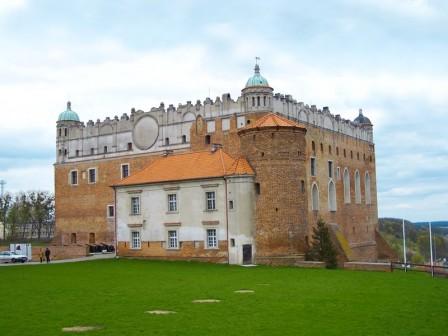Golub Dobrzyń
| During his stay in Szafarnia, Fryderyk Chopin used to visit the town of Dobrzyń upon the Drwęca River and the town of Golub, which were then divided by the Drwęca River and a border established by occupants. In Golub, little Fryderyk visited the former Teutonic castle, which was then ruined, and standing in the pulpit of the Evangelical church, which was then under construction, he read his own texts to other visitors. In the town market he saw more wooden and half-timbered houses than the one still standing in the market. He admired the Gothic parish church with its rarely found clearance under the tower and considerable sections of fortified walls with towers around the town. Visiting Dobrzyń, he could not have missed the new church erected in the Classical style (a parish church since 1909), as it had been founded by Antoni Wybraniecki of Sokołowo, Chopin’s acquaintance. |  |
The research conducted in the castle proved that settlements and wooden and ground fortifications had existed in the site as early as in the 8th and 9th centuries. The erection of the brick castle commenced at the end of the 13th century and the castle soon became the seat of the Teutonic commander of Golub. The settlement of Golub was mentioned for the first time in 1258, however, the original town charter was lost. The Teutonic knights left Golub to go to war with its main stage being the battle of Grunwald and the final stage being the signature of the First Peace Treaty of Toruń. Upon signing of the Second Peace Treaty of Toruń in 1466, the castle became the seat of Polish prefects such as Anna Wazówna, a sister to Zygmunt III Waza. Anna Wazówna rebuilt the castle in the spirit of the Renaissance. Due to the Polish-Swedish wars in the 17th century, marching of various troops in the 18th century as well as carelessness of subsequent prefects and complete lack of maintenance after the First Partition of Poland, the castle was destroyed and ruined. Throughout the 19th century and a half of the 20th century the castle served various functions. It was renovated in the years 1947 – 1953 and since 1964, owing to mgr Zygmunt Kwiatkowski, a history teacher, and activists of the local PTTK branch, the castle was restored. The former suburbs located on the left bank of the Drwęca river were named Dobrzyń by Ignacy Działyński at the end of the 18th century (the suburbs may have also been referred to as Morzyn). Owing to efforts of Ignacy Działyński, the town was granted a town charter. Both cities were united only in 1951 and now are referred to as Golub – Dobrzyń.
Developed by: Andrzej Hermann
See other localities on the Fryderyk Chopin Route in the Kujawsko-Pomorskie Province
Angielski
Tytuł:
Golub Dobrzyń


